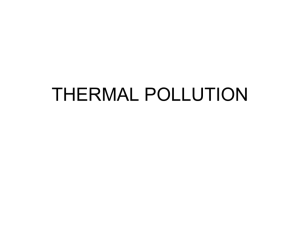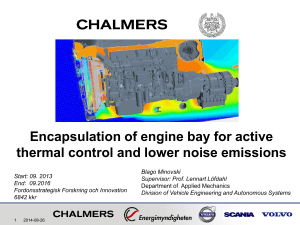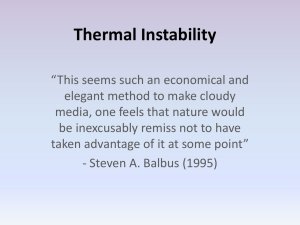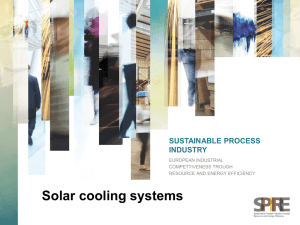why thermal management? - Department of Electrical, Computer
advertisement
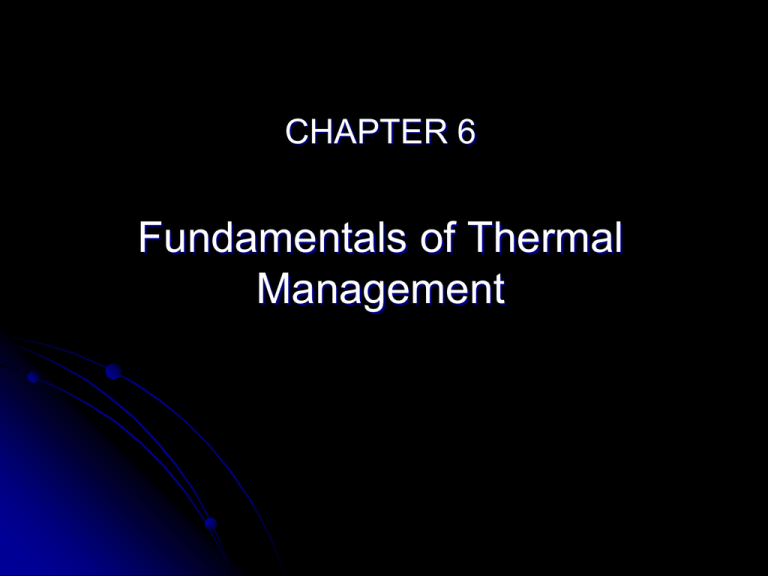
CHAPTER 6 Fundamentals of Thermal Management 6.1 WHAT IS THERMAL MANAGEMENT? Resistance of electrical flow Absence of cooling Contact of Device • • Steady State • Cooling roles Intense Heat Transfer Successful Thermal Packaging X 6.2 WHY THERMAL MANAGEMENT? Thermal Management of all microelectronic components is similar Prevention of Catastrophic failure Temperature rise Catastrophic vulnerability X 6.2 Why Thermal Management cont. Failure Rate Increases with Temperature Reliability X 6.2 Why Thermal Management cont. X 6.2 Why Thermal Management cont. The main thermal transport mechanisms and the commonly used heat removal is different in each packaging level. Level 1 Level 2 Level 3 and 4 X 6.2 Why Thermal Management cont. X 6.3 Cooling Requirements for Microsystems Cooling techniques Buoyancy- induced natural circulation of air Natural convection cooling Forced convection Heat-sink-assisted air cooling 6.3 Cooling Requirements for Microsystems cont. 6.4 Thermal Management Fundamental Electronic cooling, there are three basic thermal transport mode Conduction (including contact resistance) Convection Radiation 6.4 Thermal Management Fundamental cont. One-dimensional Conduction X 6.4 Thermal Management Fundamental cont. Heat flow across solid interface Perfect adhering solids Ac = area of actual Real Surface contact Av = fluid conduction across the open spaces. X 6.4 Thermal Management Fundamental cont. Convection Two mechanism X 6.4 Thermal Management Fundamental cont. X 6.4 Thermal Management Fundamental cont. X 6.4 Thermal Management Fundamental cont. X 6.4 Thermal Management Fundamental cont. Thermal Resistant in Parallel X 6.5 Thermal Management of IC and PWB Packages cont. Natural Convection air cooling of Electronic equipment still very popular Simplicity, reliability and low cost IC packages, PCB’s, heat sinks Single PWB Array of PWB’s-array of vertical channels Nusselt Number: Nu=El/C2A, El=Elenbaas number Measures the enhancement of heat transfer from a surface that occurs in a real situation, compared to heat transferred if just conduction occurred. Dimensionless quantity 6.5 Thermal Management of IC and PWB Packages cont. Optimum Spacing Isothermal arrays the optimum spacing maximizes the total heat transfer Optimum PWB spacing where max power can be dissipated in the PWB’s Limitations-closely spaced PWB’s tend to under predict heat transfer Due to between package “wall flow” and the non smooth nature of channel surfaces 6.5 Thermal Management of IC and PWB Packages cont. PWB’s in Forced Convection Most applications Laminar Flow- the flow of cooling air proceeds downstream between the PWB’s in “sheet-like” fashion. Forced laminar flow in long, or narrow parallel plate channels the heat transfer coefficient has an asymptotic value of: h=4kf/de. Where de=Hydraulic diameter 6.6 Electronic Cooling Methods Heat Sinks Convective thermal resistance can be reduced by Increasing heat transfer coefficient or Increasing heat transfer area Coefficient is function of flow conditions which are fixed Most applications-increase heat transfer area provides only means to reduce convective thermal resistance- by use of extended surfaces or fins 6.6 Electronic Cooling Methods cont. Heat Sinks continued: The temperature of the fin is expected to decrease from the base temperature as move toward the fin tip Amount of convective heat transfer depends on the temperature difference between the fin and ambient Heat transfer from fin area: q=ηhAf(Tb-Ta) Af Base area Η fin efficiency Tb base temperature Single plate fin, most thermally effective use of fin material achieved when efficiency is 0.63 6.6 Electronic Cooling Methods Cont. Heat Sinks continued: “extended” surfaces Manufacturer provides heat sink thermal resistance for range of flow rates Most common are extruded heat sinks Limitation on fin height to fin gap due to structural strength. k xyz tM kM 1 (1 t M ) k1 6.6 Electronic Cooling Methods cont. Thermal Vias cont. Large number of Vias-Qzz model to determine thermal conductivity: kzz=kMaM + k1(1 – aM) kM & k1 are the thermal conductivity of the metal and insulator and aM is the fraction of cross-sectional conductivity in Zdirection Sparse amt. of vias-Qxyz model: “In-plane” thermal conductivity to first approximationcombination of vias may be neglected 6.6 Electronic Cooling Methods cont. Thermal Vias VIA PCB design-pad with plated hole that connects copper tracks from one layer of the board to other layers Help to reduce resistance in heat flow Examine thermal conductivity both analytically and experimentally 6.6 Electronic Cooling Methods cont. 6.6 Electronic Cooling Methods cont. Thermal Vias cont. Trace layers Can help to transport heat to the edges of the board Finite Element model simulation 6.6 Electronic Cooling Methods cont. Flotherm-3D computational fluid dynamics software Predicts airflow and heat transfer in electronic models Conduction, convection and radiation 6.6 Electronic Cooling Methods Flowtherm Model used for Covidien’s ERT project Sensor module Completely EM shielded 6.6 Electronic Cooling Methods cont. Heat Pipe Cooling Thermal transport device uses phase change processes and vapor diffusion to transfer large quantities of heat over substantial distances with no moving parts and constant temp Use is increasing especially in laptops High effective thermal conductivity of heat pipe at low weight 6.6 Electronic Cooling Methods cont. Heat Pipe Cooling cont 3 sections Evaporator-heat absorbed and fluid vaporized Condenser-vapor condensed and heat rejected Adiabatic-vapor and the liquid phases of the fluid flow in opposite directions through the cork and wick 6.6 Electronic Cooling Methods cont. Heat Pipe Cooling Most cylindrical in shape Variety of shapes possible Right angle bends, S-turns, spirals… .3cm minimum thickness Concerns Degradation over time Some fail just after a few months operation Contamination and trapping of air that occur during fabrication process 6.6 Electronic Cooling Methods cont. Jet Impingement Cooling Used when high convective heat transfer rates required For unpinned heat sink, the multiple jets yield higher convective coefficients that single jet by a factor of 1.2 In presence of pins, almost no difference is seen 6.6 Electronic Cooling Methods cont. Immersion Cooling Dates back to 1940’s Mid 80’s- used in Cray 2 and ETA010 supercomputers Well suited to cooling of advanced electronics under development Operate in closed loop 6.6 Electronic Cooling Methods cont. Immersion Cooling 6.6 Electronic Cooling Methods cont. Immersion Cooling 6.6 Electronic Cooling Methods cont. Thermoelectric Cooling TEC-Thermal electric cooler-solid state heat pump Potential placed across 2 junctions-heat absorbed into one junction and expelled from another Most obvious in P-N junctions e- transported from p-side to n-side, transported to higher energy state and absorb heat thus cooling surrounding area From n-side to p-side they release heat Common materials- bismuth telluride, lead telluride, and silicon germanium Selected from performance and COP (coefficient of performance) curves
